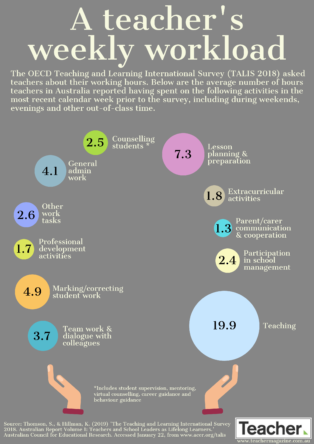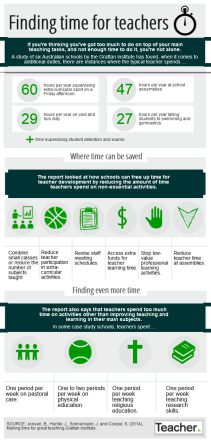An overwhelming majority of teachers don’t get enough time to prepare for effective classroom practice or high-quality lesson planning, according to new Australian research.
‘[Teachers] are telling us they are too stretched to do everything we ask of them … they report feeling overwhelmed by everything they are expected to achieve. Worryingly, many school leaders feel powerless to support them,’ the Grattan Institute report (Hunter & Sonnemann, 2022) says, adding teaching quality is suffering and students are losing out.
Researchers surveyed 5442 teachers and school leaders – working in all sectors, and across all states and territories – about their preparation for effective teaching, any obstacles to their core work, and what would make things easier.
What did teachers and leaders say?
The researchers define ‘preparation’ as including planning for classroom instruction; analysing student work, preparing feedback, planning to support those students who are struggling, and improving their own professional practice.
The overwhelming majority of teachers surveyed (92 per cent) said they ‘always’ or ‘frequently’ don’t have enough time to prepare for effective teaching. The report says this finding holds for all states and territories, primary and secondary schools, all school sectors, and advantaged and disadvantaged schools. Digging deeper into the responses to this question – the figure was 86 per cent for teachers with less than two years’ experience and 93 per cent for those with more than 10 years.
Just over three-quarters of school leaders surveyed (77 per cent) also said their teachers ‘always’ or ‘frequently’ don’t have enough time to prepare for effective teaching.
Researchers also asked about time for planning. ‘A large majority (86 per cent) of teachers said they “always” or “frequently” feel like they do not have sufficient time for high-quality lesson planning,’ the report says. ‘Again, these results hold across primary and secondary schools, states and territories, school sectors, levels of advantage, and for teachers at all stages of their careers.’
Teachers spoke about the challenges that limit the time they can spend on planning and preparation. When asked to rate the barriers that were a major issue at their own school, the top three choices were: the workload for what effective teaching entails is too high (86 per cent); not enough personal downtime for teachers to re-charge (78 per cent); and frequent introduction of initiatives by government and school leaders (76 per cent).
Here are some of the individual teacher comments shared in the Grattan Institute report:
‘Administration time takes up most of planning time. Such as communication to parents, newsletters, displays, notes, permission slips, phone calls, and talking to students about wellbeing issues.’
‘With the constant new “initiatives”, and department/partnership/region/school priorities, nothing ever drops off or is replaced by the new foci, it’s just added on top of what we already do.’
‘[There are] not enough ready-made resources to support students with complex learning needs. Along with this, [there is] a lack of professional development available to support teachers in learning to teach and support students with disabilities and complex needs.’
‘As a middle leader and experienced teacher, I spend very little time on preparing lessons that enable me to teach how I would like. All of my time is taken up in meetings, dealing with student and parent issues, and also solving staff crises.’
Recommendations for change
The report outlines the current situation for teachers in Australian schools.
‘Teachers generally teach classes for about 20-to-22 hours a week, with most primary teachers generally expected to teach a couple of hours more than secondary teachers. On top of that, they must fit in classroom preparation, marking, professional learning, and a range of “other duties” such as yard duty, meetings, supervision of extra-curricular activities, support for student wellbeing or behaviour management, communication with parents, and much more.’
It says, in theory, these demands need to be squeezed into 38 hours but, on average, teachers report working 44 hours a week during the school term. So, what is the solution?
The researchers propose three recommendations for government reform:
- better matching teacher’s work to their expertise (for example, having other staff cover extra-curricular activities);
- making lesson and curriculum planning more efficient (for example, making resources available to reduce the need for teachers to ‘reinvent the wheel’); and,
- rethink work organisation (for example, giving school leaders flexibility on issues such as class sizes and face-to-face teaching time).
Practical steps school leaders can take now
Another recommendation is for school systems in all sectors to provide more training and guidance for leaders to make the best decisions for their local context. To accompany the report, the Grattan Institute has published a guide for principals on the practical steps they can already take to free up time for teachers.
The report says the approach taken will differ between schools, and leaders should think about a combination of strategies. It recommends school leaders adopt four strategies:
Manage teachers’ time strategically. Setting clear priorities and allocating resources accordingly; having a clear picture of what’s happening in school for teachers and students means resources can be allocated strategically.
Let teachers teach, by better matching their work to their expertise. This includes delegating to other staff tasks that don’t require teaching expertise, and drawing effectively on specialist and support staff for complex teaching and learning tasks. The survey suggests an extra two hours a week could be freed up for teachers if non-teaching staff took on extra-curricular tasks such as yard duty.
Help teachers to work smarter, by reducing unnecessary tasks. This includes streamlining curriculum planning, reducing the variety of subjects for individual teachers, cutting back on lower-priority extra-curricular activities, and reducing the number of meetings and administrative requirements.
Rethink the way teachers’ work is organised. Increase class sizes to ‘buy’ extra preparation time (where appropriate), streamline curriculum offerings, and use non-term time for collaborative teacher preparation. Most of the teachers and leaders in the survey said spending an extra two or three days working with colleagues before the start of term would reduce term-time workload, (Hunter et al., 2022).
You can find more details on the survey responses, recommendations and strategies for school leaders – along with examples from Australian schools and education policies in other countries – in the main report and principal guide.
References
Hunter, J., & Sonnemann, J. (2022). Making time for great teaching: How better government policy can help. Grattan Institute. https://grattan.edu.au/wp-content/uploads/2022/01/Making-time-for-great-teaching-how-better-government-policy-can-help-Grattan-Report.pdf (PDF, 5.1MB)
Hunter, J., Sonnemann, J., & Haywood, A. (2022). Making time for great teaching: A guide for principals. Grattan Institute. https://grattan.edu.au/wp-content/uploads/2022/01/Making-Time-For-Great-Teaching-A-Guide-For-Principals.pdf (PDF, 5.6MB)
As a principal, what’s the situation in your own school? Have you consulted with teachers and non-teaching staff? What are the priorities for your school? Is there a more efficient and strategic way that you could allocate resources?
Thinking about the tasks that teachers do: Is this the best use of their expertise? Could support staff, such as teacher aides, do some of these tasks to free up more time for teachers?



